The Marketing Planning Process: Step-by-Step Breakdown

Sorry, there were no results found for “”
Sorry, there were no results found for “”
Sorry, there were no results found for “”
Want to learn about the different steps that go into the marketing planning process? Managing a marketing project is a bit like managing a fast-food restaurant.
You have a very limited time to prepare the product (campaign). And you have to coordinate with staff members who are handling completely different duties. If it’s done right, you’ll be attracting a ton of loyal (and hungry) customers.
In this article, we’ll take a look at the strategic marketing plan process, how you can implement it in your business, and the best tool to help you with the entire process.
Order up! Let’s go.
A marketing plan is a document that showcases your company’s marketing strategy for the upcoming month, quarter, or year.
Here’s what a marketing action plan contains when you unbox it:
And what happens when you create an amazing marketing plan? You’ll be able to stay focused on your marketing goal and also create an equally amazing marketing strategy. Here’s how you can create a marketing campaign that can make even the pros jealous!
Marketing efforts, when done right, can result in significant positive effects that can kickstart your business’s success. Here are a few benefits of proactive marketing planning.
Learn about the top marketing tools for new businesses!
Through the planning process, you will be able to set benchmarks and create a roadmap for your marketing strategy to reach business goals. Making this visible allows the entire team to be accountable for their actions and tasks. It will also ensure everything runs smoothly as everyone knows what’s happening and how they need to work together.
Because the marketing planning process will likely run across departments and need a fair bit of collaboration, it opens up cross-departmental communication and unifies the organization. Also, getting your team involved early allows you to be realistic with your planning.

Now, you have a marketing strategy. By having a planning process in place, you now have a framework to gain an overview of the target market, competitive advantage, and market segmentation. This allows you to be better prepared for risk factors that you might not have foreseen.
Since business is always changing, having a marketing planning process allows you to keep adapting more effective strategies. By continually honing your marketing efforts, you might run across new tools and techniques, incorporate new ideas from different team members, and challenge your standard operating procedures.
Creating a marketing plan for the first time might seem like a convoluted process, but it’s actually super simple. The planning process becomes 100x easier to deal with when you break it down into these six steps:
Let’s take a closer look at each step.
Before planning a marketing strategy, you and your marketing team should ask your senior management to highlight your corporate objectives.
Ideally, every large-scale business goal and objective should span 18-24 months. This gives you enough time to develop marketing initiatives that align with these overall business objectives.
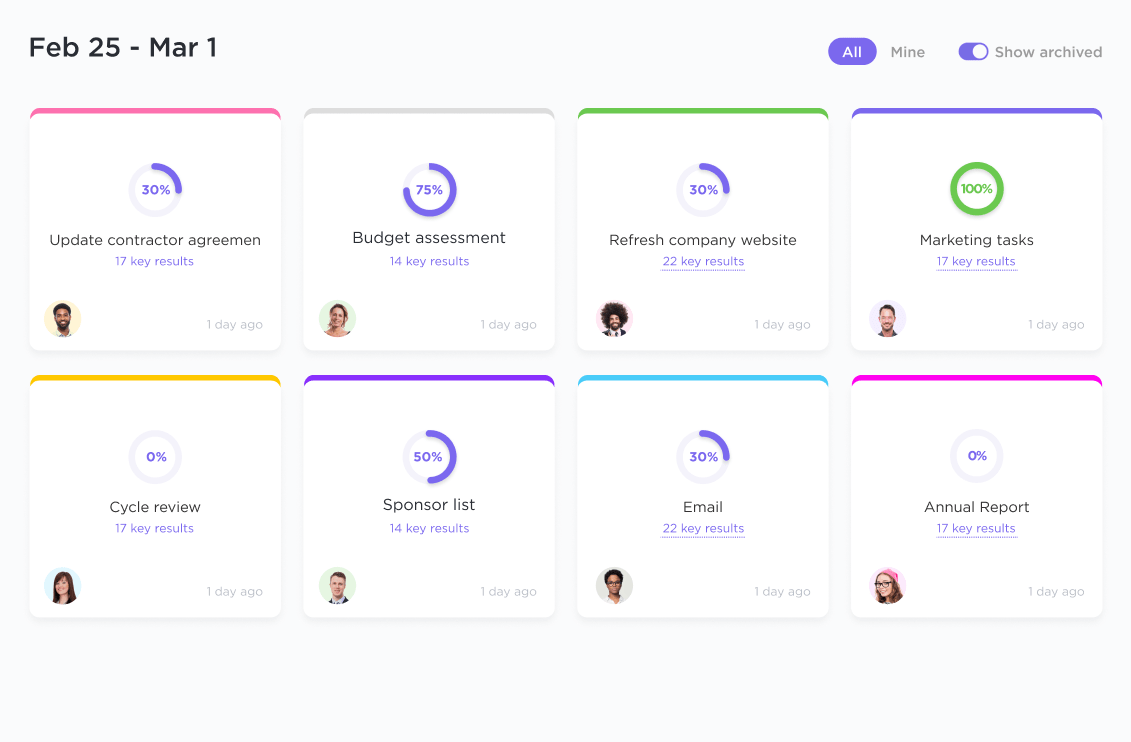
Let’s say you’re the marketing manager for Los Pollos Hermanos from Breaking Bad. The business owner, Gus Fring’s business goal might be to increase restaurant revenue to $3 million in the next year.
You’ll need to create a SMART marketing goal that can contribute to his business goals. For example:
Curious about SMART goals? Check out our guide for tips on how to create a great business goal.
After you’ve decided on the goal, marketing project management tools like ClickUp can help you document and track them. In ClickUp, Goals are high-level containers that can be broken into smaller objectives, known as Targets. Targets can be measured by units like numbers, $$$, true/false, and task lists.
Bonus: Marketing Tools for Small Businesses
When you meet your Targets, you achieve your marketing goal too. ClickUp automatically updates the progress percentage as you meet Targets in real-time. This can motivate your sales and marketing teams as they see the numbers rising every day!
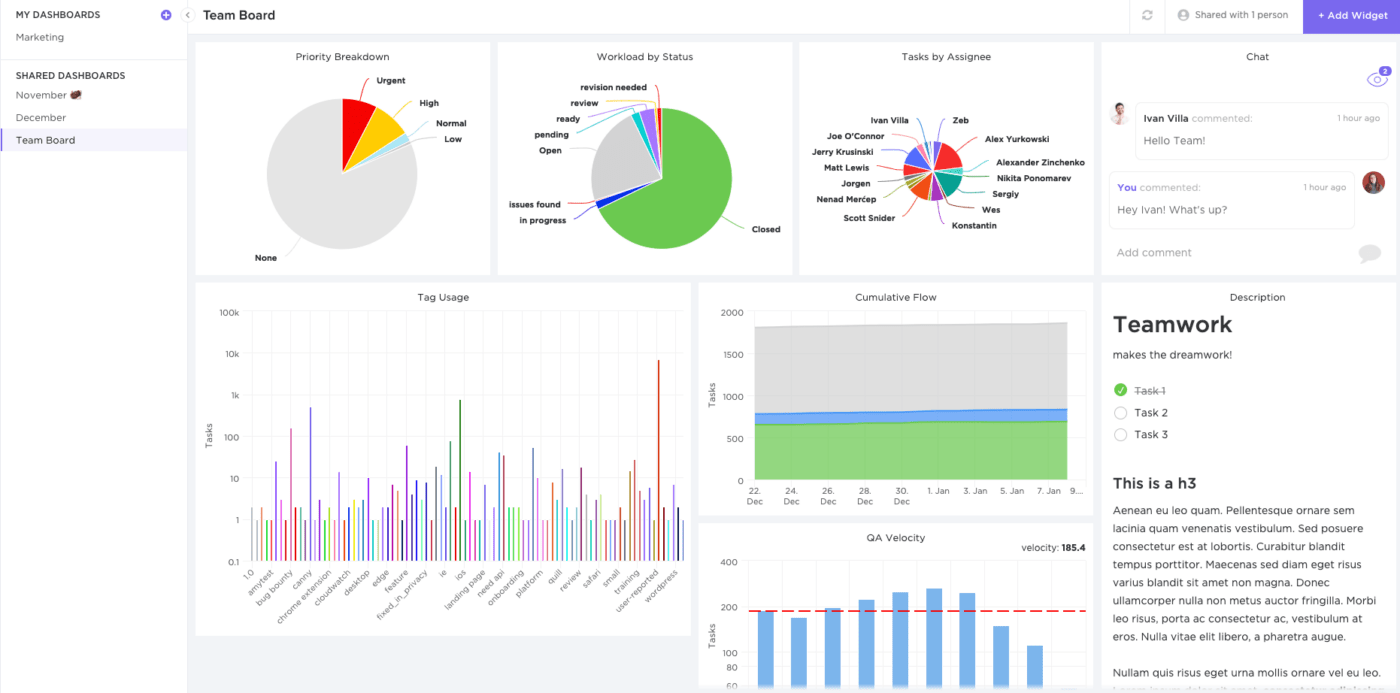
Want to monitor more marketing metrics?
ClickUp is loaded with features that your teams need to manage your project or marketing program. Its Dashboards are the way to go. Each unique dashboard offers a lot of Custom Widgets that let you track marketing KPIs and every marketing objective.
Track sales, conversion rates, social media engagement, and more, with a Line Chart, Bar Chart, Pie Chart, Battery Chart, or however you best visualize data!
Want to get there faster? Use the ClickUp Content Management Template to easily track your content goals, budgets, and resources all within one space. Get this content branding template for free!
It’s time for a serious throwback. You need to take a look at all the marketing decisions and initiatives that you’ve taken in the past few years. Additionally, you’ll also have to go through old reports to see which marketing tactics worked and which didn’t.
But why?
With the help of a marketing audit, you’ll be able to avoid the issues your marketing department has faced in the past. Take it from Gus: ClickUp Docs let your team collaborate in real-time on your audit, marketing research, and annual marketing plan documents; it’s like Google Docs, but way better!
Not only can you embed lists, tables, images, and videos, but you can also assign actionable tasks directly within a ClickUp Doc. And to make your job even easier, ClickUp lets you save your work as a marketing plan template that you can use later!
After the audit, you’ll need to determine where you’re currently placed in the market and market trends. Ask your team:
But why just limit feedback to your company? Your customers and clients’ opinion matter too.
After all, they’ll be using your products or services. With the Form view, you can create detailed customer survey forms faster than you can say Heisenberg.
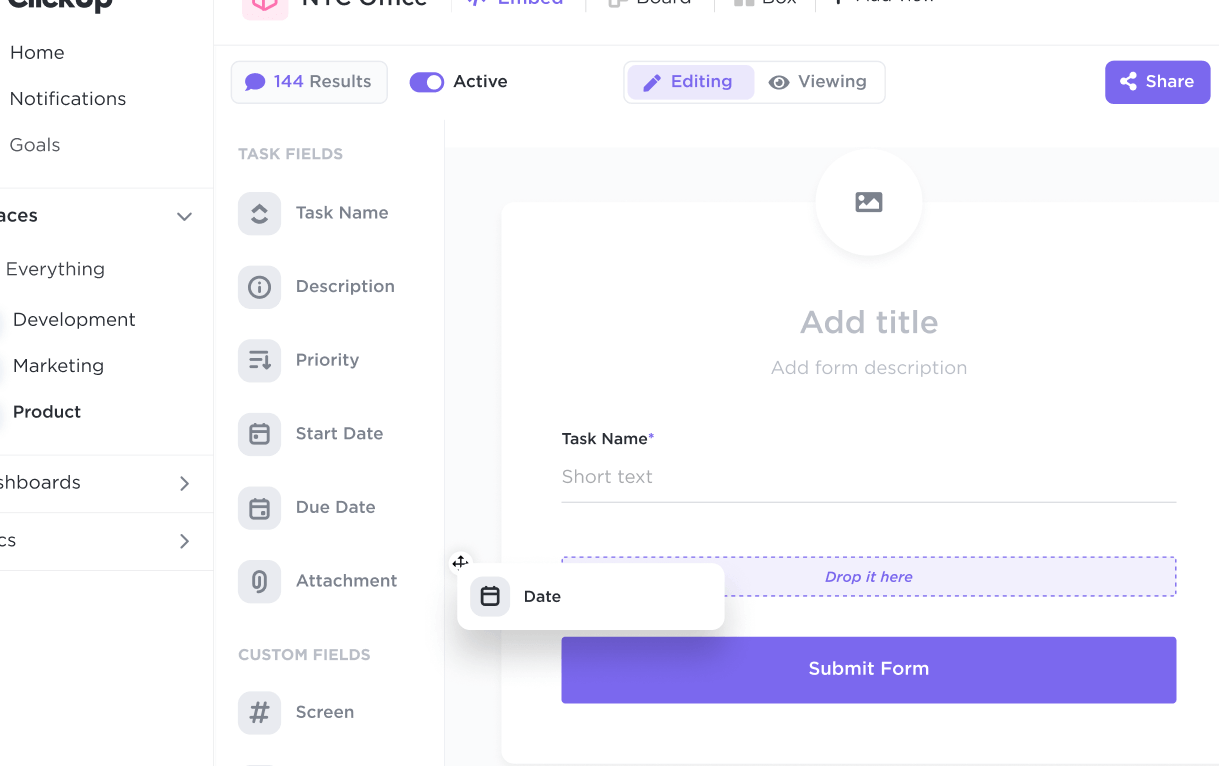
Choose from different fields of text, labels, questions, and more. ClickUp allows you to publicly share these forms, and it then collects responses within the tool. This way, you can directly take action on their responses by including their inputs in the marketing plan.
How well do you know your customers, really? In this phase, you’ll need to embrace market segmentation. What’s that?
Essentially, you’ll need to identify the different kinds of customers in your target market. Then you’ll have to narrow your focus to a specific target audience. After that, you’ll have to create a buyer persona. These are fictional representations of your ideal customer in your target market. Ask your team:
You’ll need to really get into their minds, so you can tailor your marketing strategy that appeals best to them. For example, Los Pollos Hermanos settles on a buyer persona named Walt, who’s a middle-aged high-school chemistry teacher.
Now that you have an idea of who he is, how he behaves, and what he wants, you can market to him better! But how do you come up with a buyer persona? Two words: Mind Maps.

Drawing Mind Maps in ClickUp can help your marketing team organize your thoughts and ideas when creating a persona. Just place a central idea and add relevant thoughts when they pop up.
And remember the more detailed the persona Mind Map, the better. Knowing your customers well will allow you to create a personalized yet strategic marketing plan that connects to your target audience.
You might have tons of cool strategic marketing ideas, but if they don’t fall into your marketing budget, it would be almost impossible to execute them. And even if you do break the bank to work on them, there are no guarantees that you’ll be rolling in dough in the end.
So how much should you spend on your strategic marketing plan? Allocating 7-15% of your company’s income to your marketing department is ideal, but it’s not a one-size-fits-all rule.
However, keep in mind that any initial marketing activity can be expensive. This includes getting a logo, branding, and creating a campaign from scratch. How do you track all your marketing expenses?
In ClickUp, every task can have additional details called Custom Fields. With these fields, you can record data like phone numbers, labels, checkboxes, and more.

In this case, you can track the budget, and cost of each marketing activity and task with the ‘Money’ field. What’s more is that with Column Calculations, you can automatically add up your spending to see whether it’s in line with your budget.
So no more half-measures when you’re creating your strategic marketing plan!
Bonus: Marketing calendar software!
Now that you know exactly what your customers are like, it’s time to choose the right distribution channels where they spend most of their time. After all, your target audience has to see your ad, right?
Let’s take a few platforms where you can implement your strategic plan, and the best tactics for each:
Let’s look back at Walt’s persona. Since we determined that he gets all his news from TV, our marketing effort should focus on creating a wonderful commercial:
Remember that the message of your strategic marketing campaign should reflect customer needs. In this case, this commercial should reassure their target audience that their food is high-quality and fresh—99.99% fresh.
However, you don’t have to focus all your tactics on one single platform. A healthy marketing mix between offline and online media ensures everyone gets your message. Now, it’s up to your marketing team to decide which route they want to take.
For example, you can create and publish new content on your blog, host automated webinars, and at the same time promote offline content to convert your audience. With ClickUp’s Chat view, you can discuss tactics, and sales deals, attach images/videos, and assign tasks in your marketing mix.
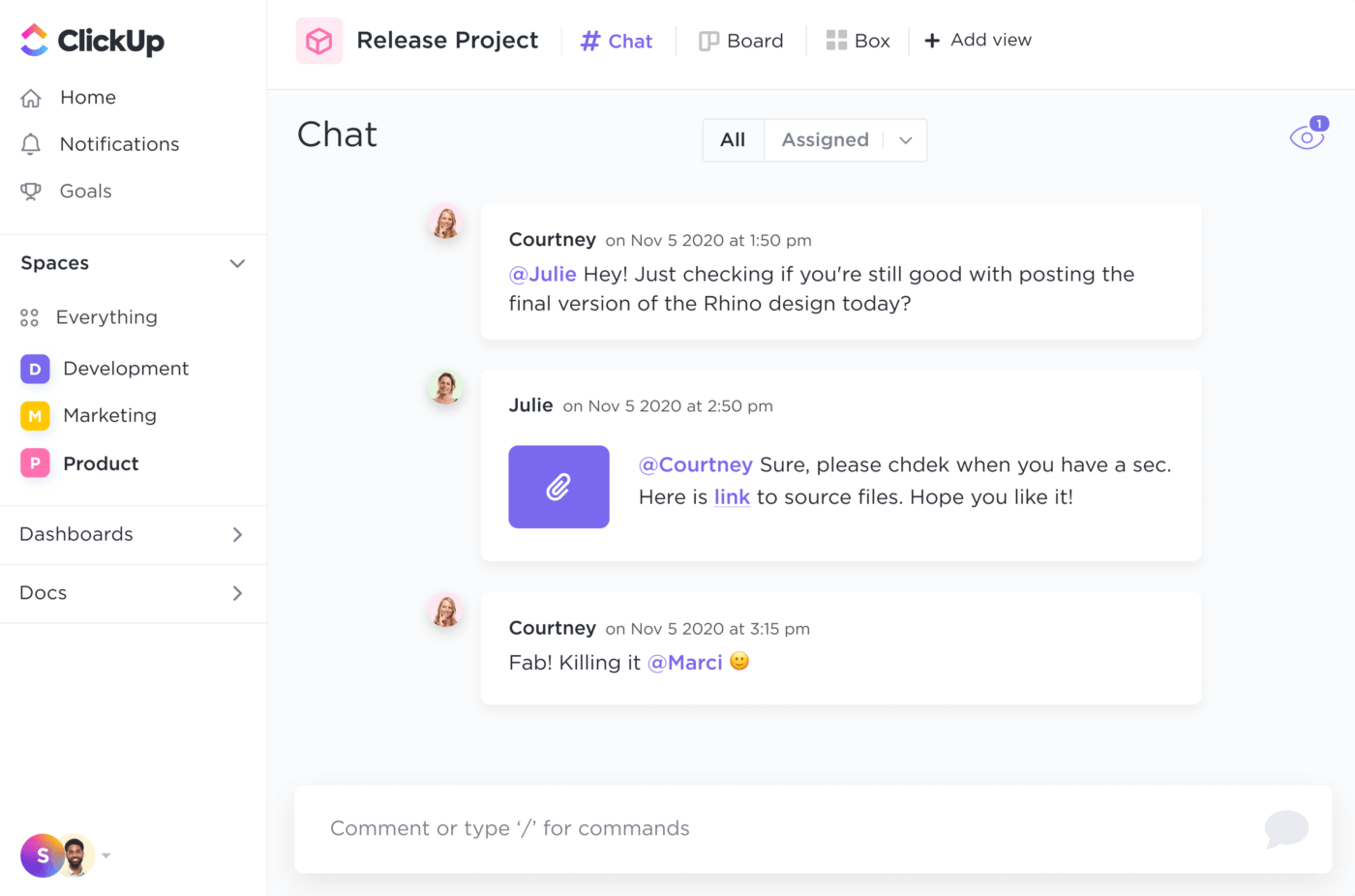
Now we’ve finally reached the end of the strategic marketing planning process. After you’ve got the marketing plan locked down, it’s time to list all the tasks that need to be done in order to pull it off.
How do you do it?
With ClickUp’s Gantt Charts, you can create a dynamic timeline of your marketing campaign activities from start to finish. The Gantt view lets you visualize the start and end dates for each task, and any important milestones along the way.
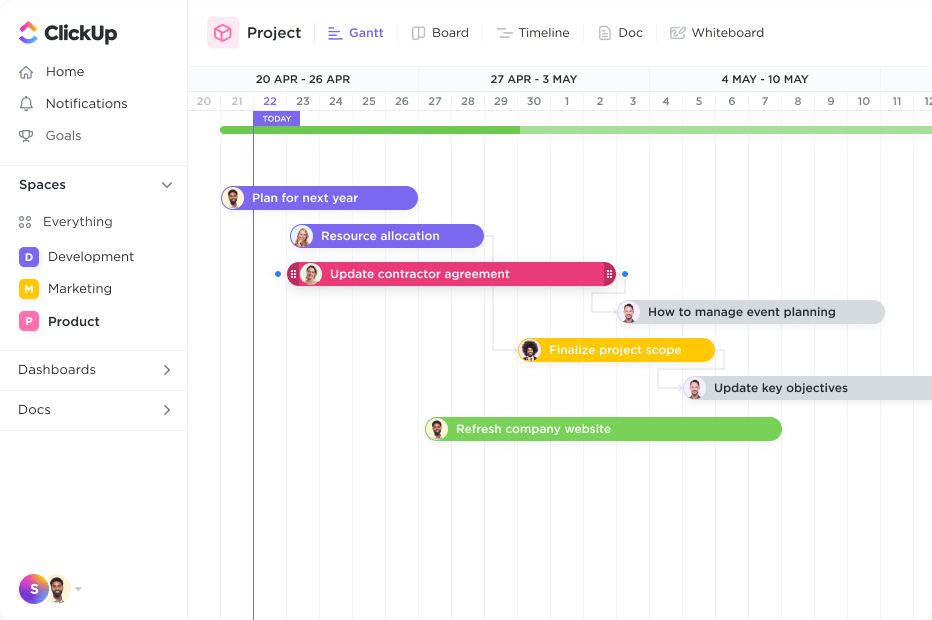
With Task Dependencies, you can indicate the sequence in which you want to complete your tasks. All you have to do is draw a line between two tasks, and you’re done!
Now, your marketing team won’t be able to work on a dependent task until they’ve cleared the preceding task. Need to work on a digital marketing calendar? You can schedule all your marketing activities through ClickUp’s Calendar view.
It’s super easy to schedule posts or tasks, and adjust due dates—all you have to do is drag and drop.
Note: Since the strategic marketing process requires your team to be quick on their feet, ClickUp offers marketing plan templates for your content calendar, SEO management, campaign tracking, promotional calendar, A/B testing, and graphic design processes.
Just apply the marketing plan template, and you’re ready to start planning in seconds! However, note that ClickUp isn’t just built for the strategic planning process; it can help with every marketing process from execution to monitoring.
So, ClickUp has more features? Here’s what ClickUp has to offer:
So what’s the secret behind running a great strategic planning session? All you need to do is figure out what your customers want, set a time and resource budget, brainstorm the best way to serve your customers, and that’s it. We told you, it’s just like the restaurant business.😁
And as most restaurants have sophisticated equipment to help you out, you’ll need a dedicated marketing automation software and project tool like ClickUp to help you out too! From Goal Trackers to Dashboards and Timelines, it’s got everything you need you to get started with your marketing plans.
Get ClickUp for free today, and cook up the perfect marketing campaigns!
Want more tips? Read our expert roundup to get more marketing management ideas.
© 2025 ClickUp